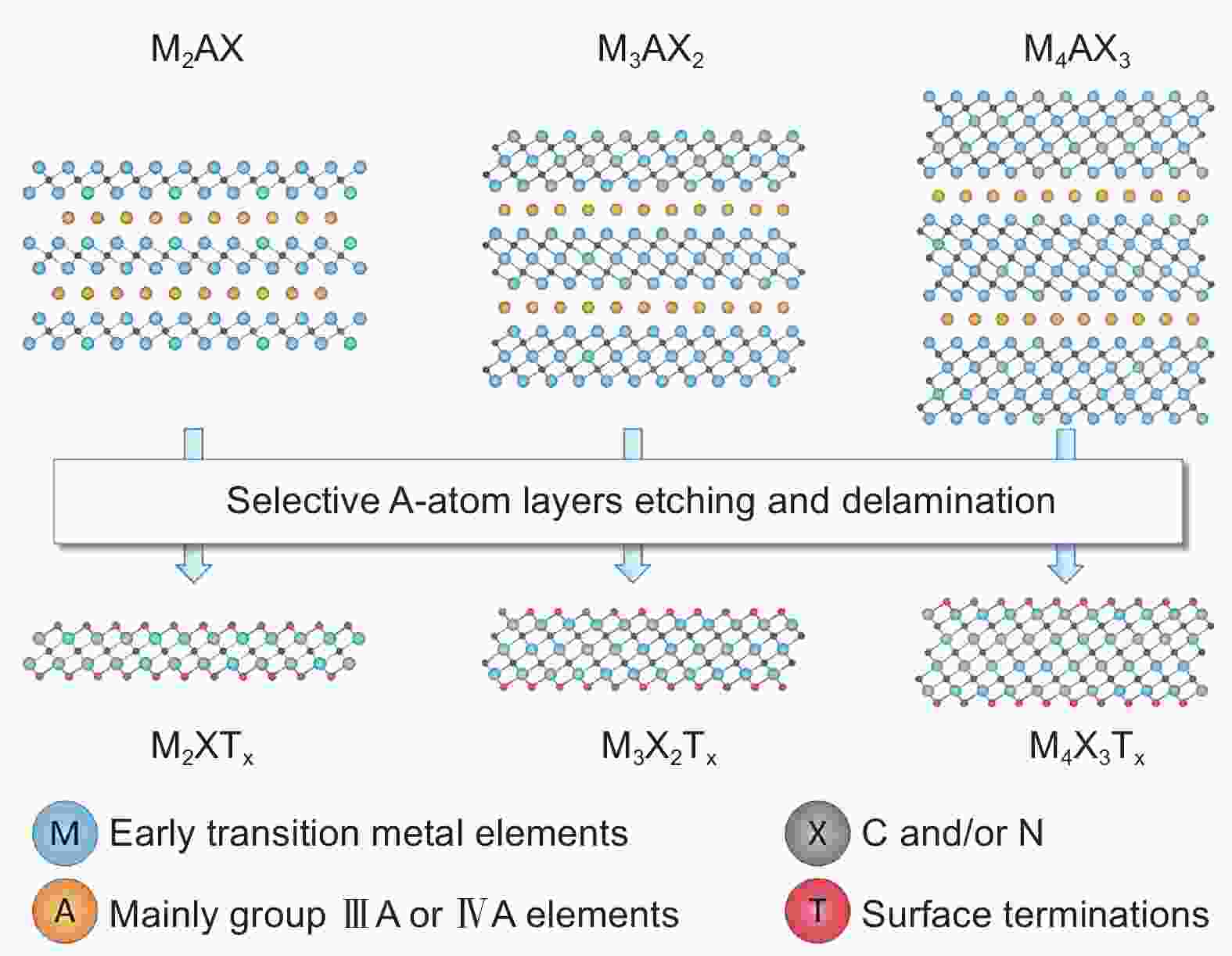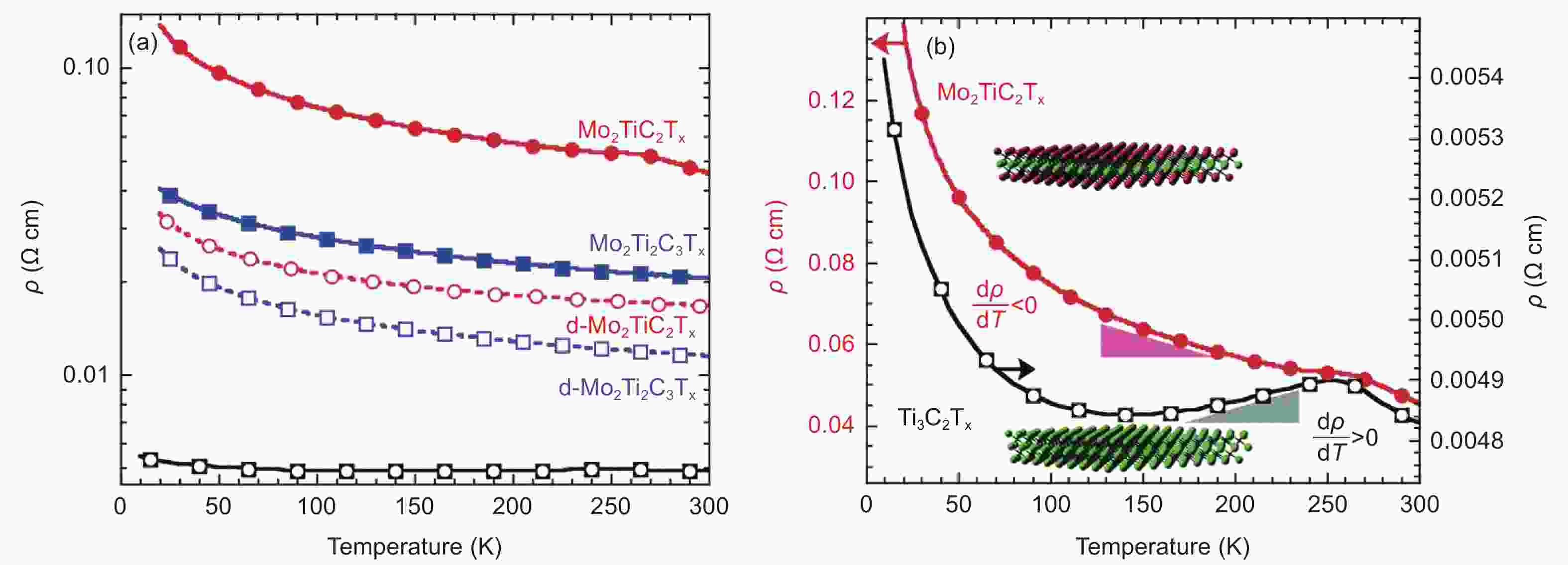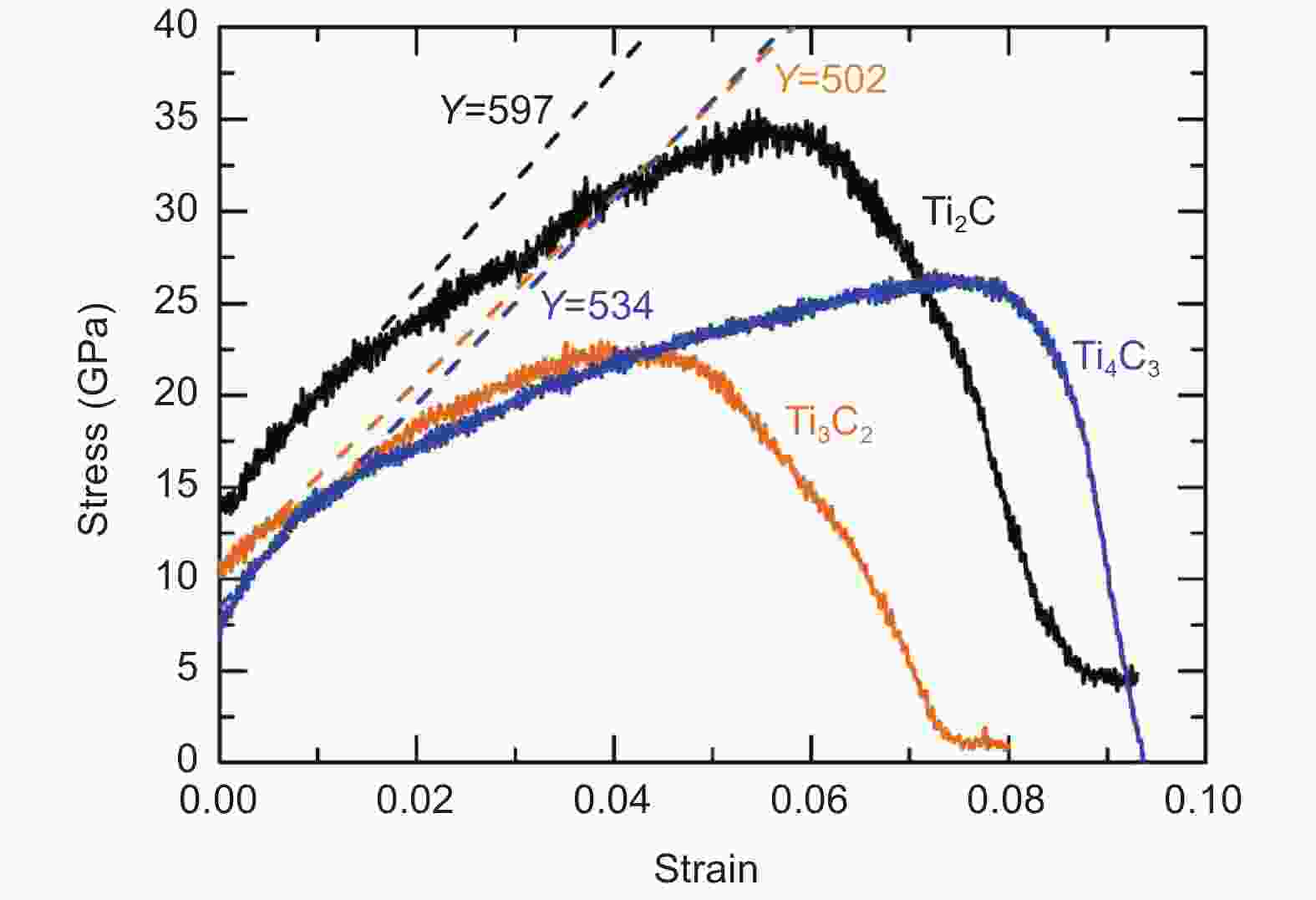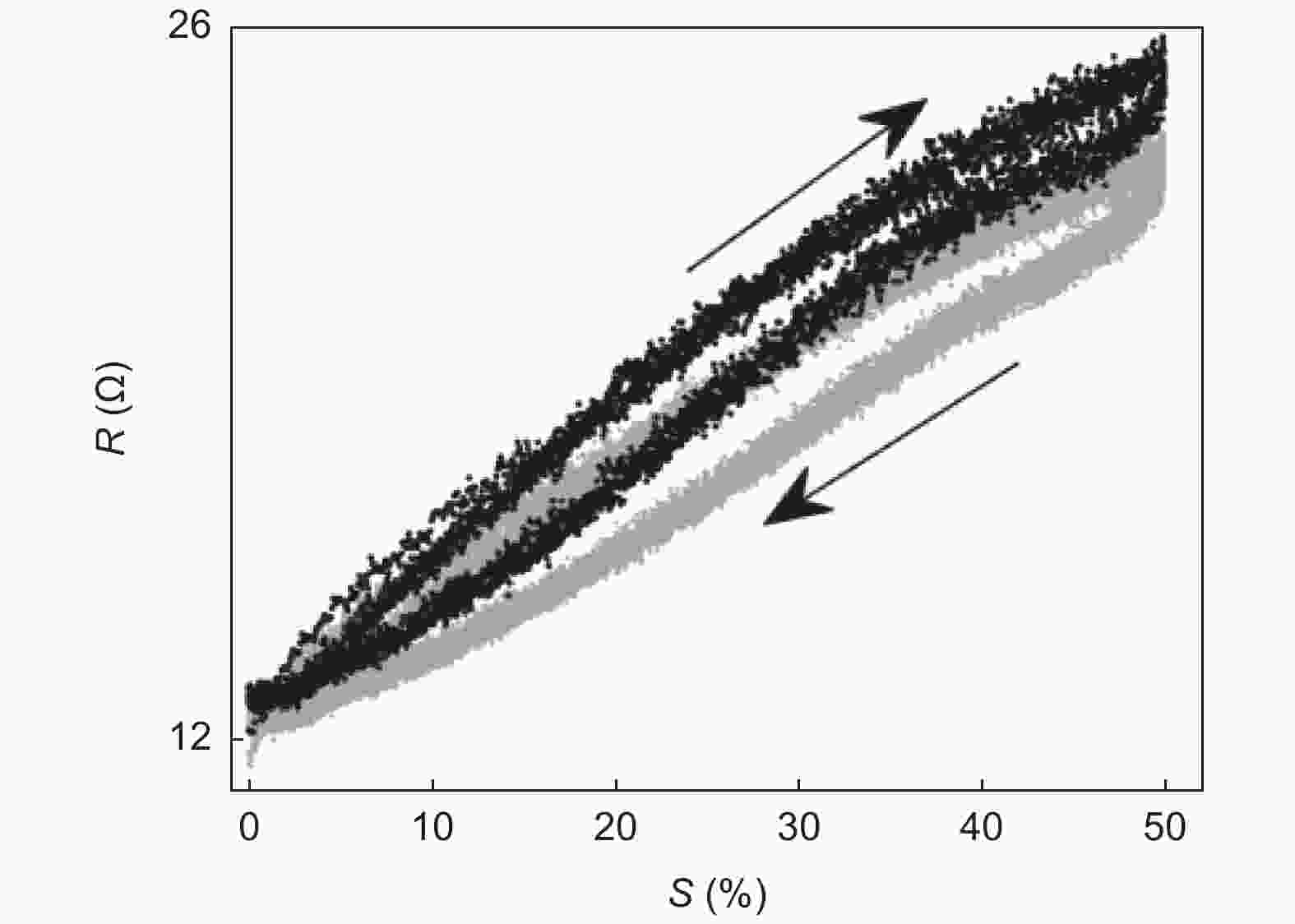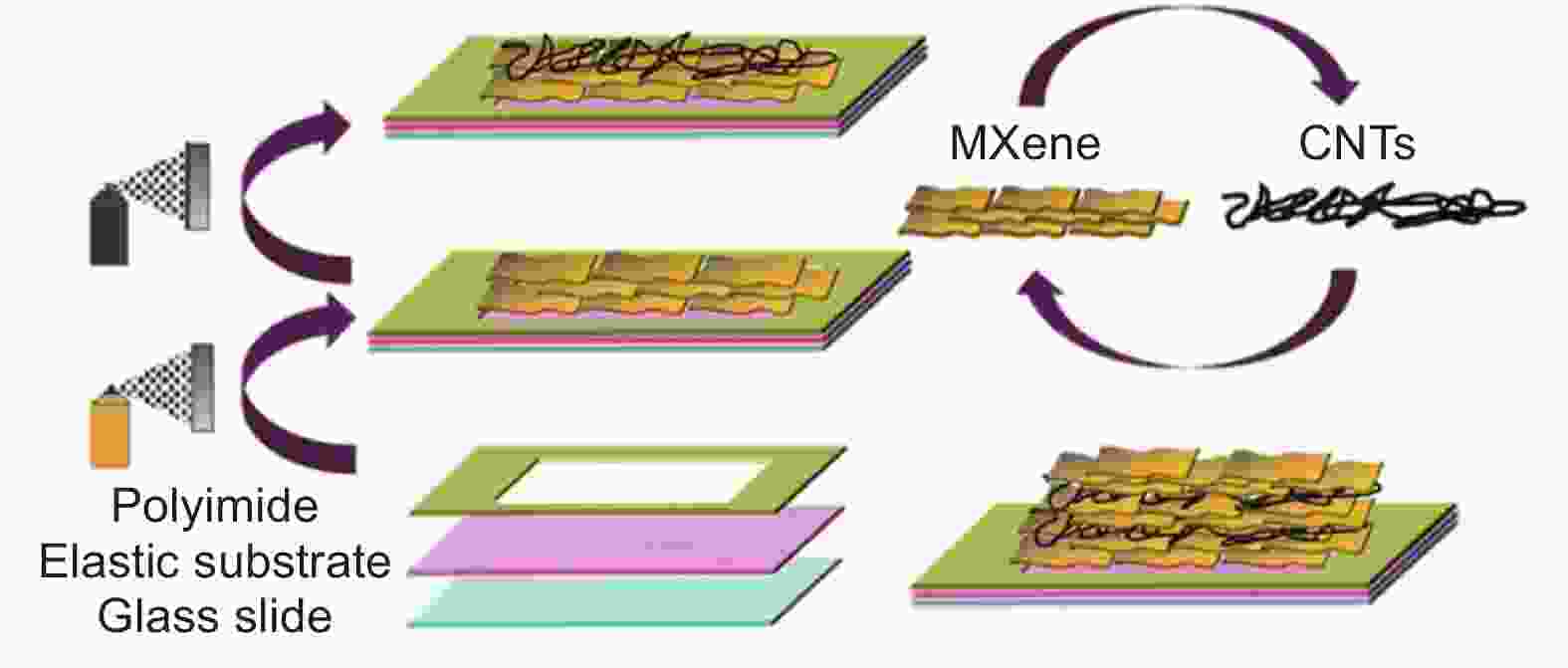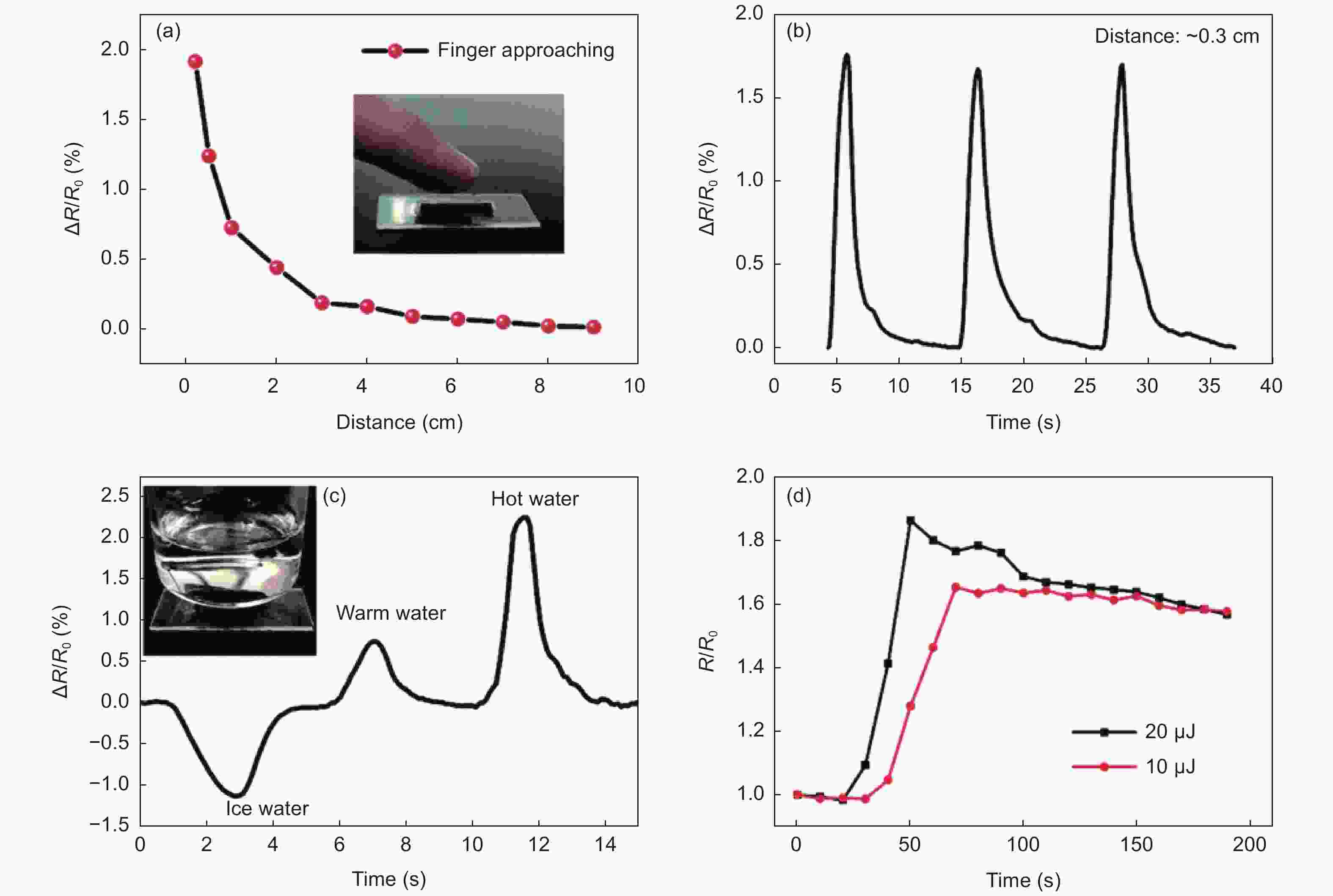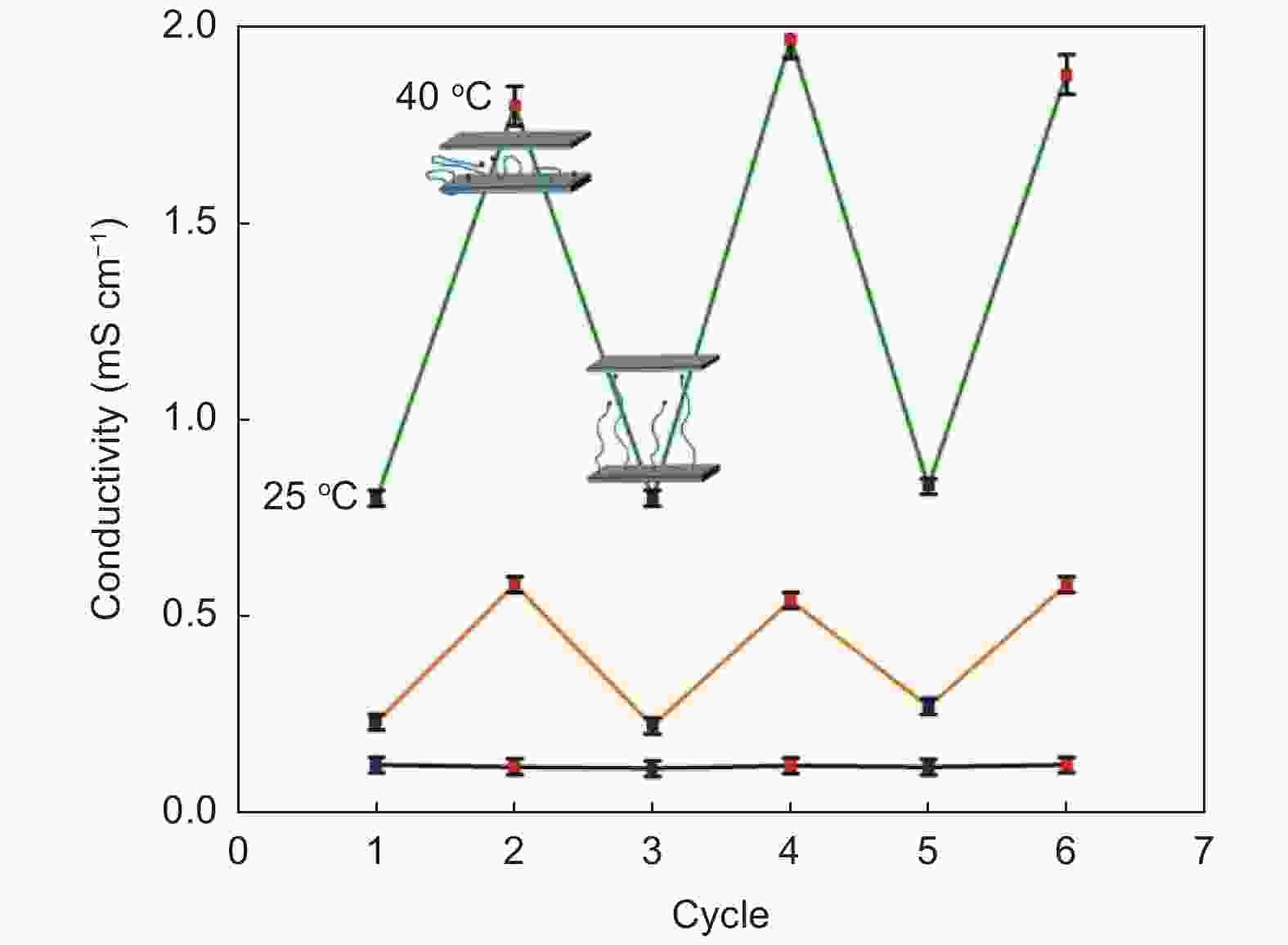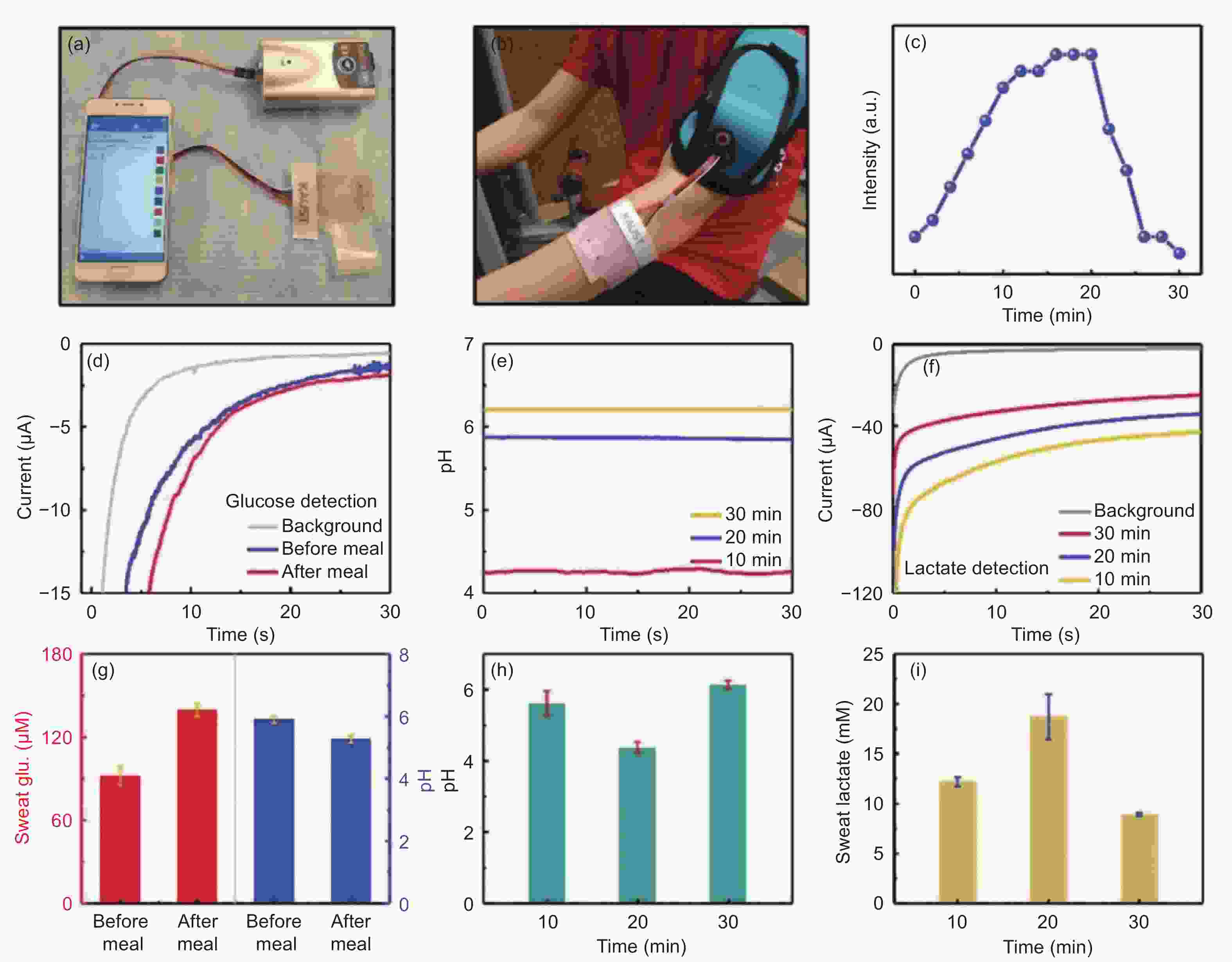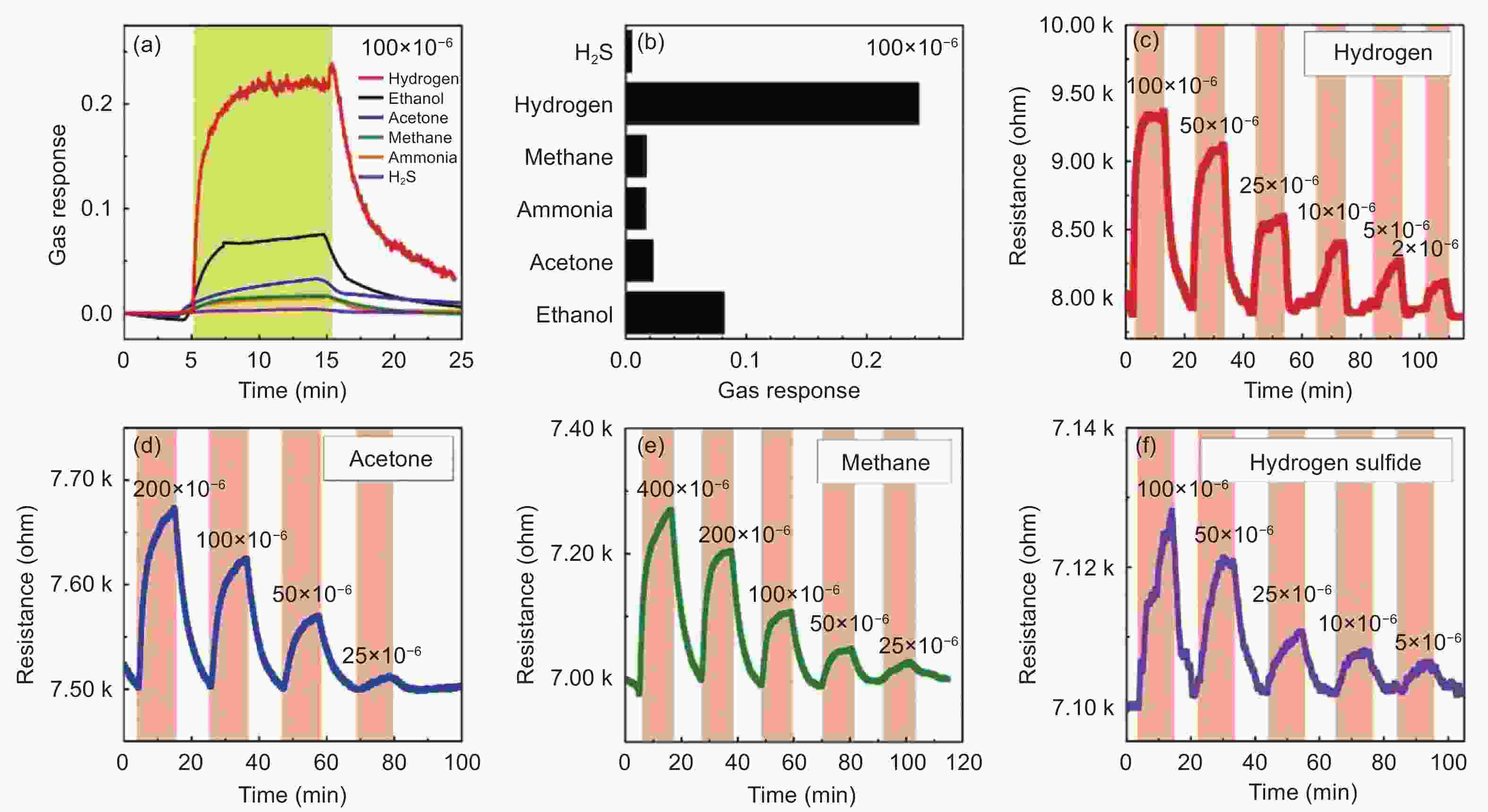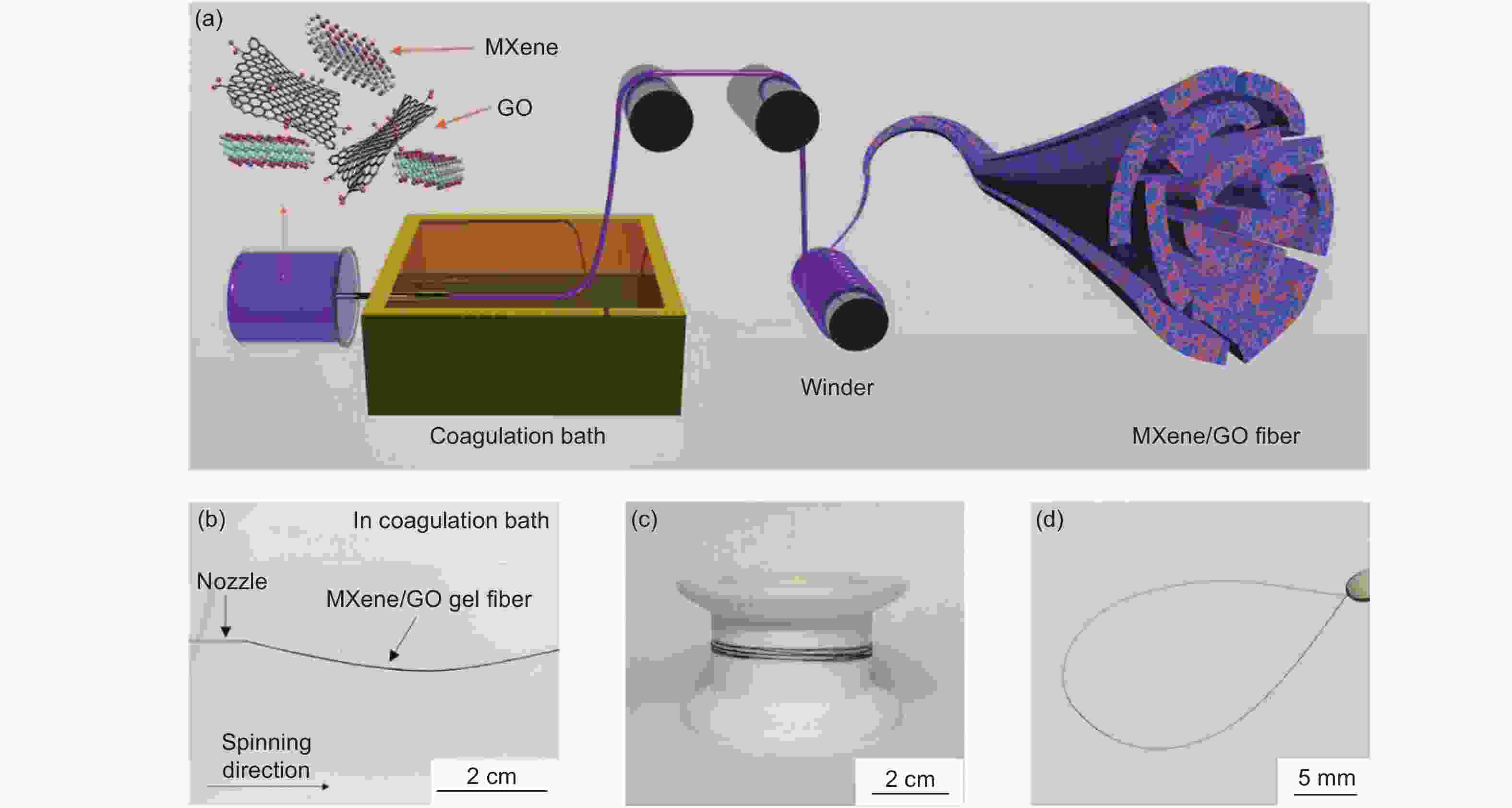-
摘要: 随着柔性电子学的快速发展,有望实现具有高灵敏度和宽检测范围的柔性传感器。近年来,二维层状过渡金属碳氮材料MXene由于具有高导电性、高比表面积、优异的亲水性及良好的机械性能等特点,且能够与包括炭材料(碳纳米管、炭纤维、石墨烯等)在内的多种材料形成性能优异的复合材料,在柔性传感器领域受到众多研究者们的关注。本综述首先介绍MXene材料的结构、合成等内容,随后总结MXene柔性传感器的结构、性能指标和常用制备工艺。在此基础上,回顾了多种MXene柔性传感器,详细介绍其传感机制和制备技术。最后,总结MXene材料用于柔性传感器的研究趋势。Abstract: The rapid development of flexible electronics has made it possible to realize flexible sensors with high sensitivity and a wide detection range. In recent years, the two-dimensional MXene layer materials composed of transition metals, carbon and/or nitrogen have attracted the attention of many researchers in the field of flexible sensors, because of their high conductivity, high specific surface area, outstanding hydrophilicity, excellent mechanical properties and other characteristics. They can be composited with other materials, such as carbon nanotubes, carbon fibers and graphene, to form a variety of materials. Here, the structure and synthesis of MXene materials are introduced, followed by a summary of their preparation methods, structures, performance and sensing mechanisms as flexible sensors. Finally, research trends for flexible sensors using MXene materials are discussed.
-
Key words:
- MXene /
- Flexible sensor /
- Composite materials /
- Sensor performance
-
图 3 通过改变外部过渡金属M层元素改变MXene电学性质[41]:(a)Mo2TiC2Tx(红色)、Mo2Ti2C3Tx(蓝色)和Ti3C2Tx(黑色)的电阻率随温度的变化,(b)电阻率比较结果,电阻率曲线下面的彩色三角形(红色和黑色)说明了dρ/dT的差异
Figure 3. The electrical properties of MXene changed by changing the external transition metal M layer elements [41]: (a) Temperature dependence of resistivity for a Mo2TiC2Tx (red), Mo2Ti2C3Tx (blue), and Ti3C2Tx (black). (b) Comparison of resistivity. The colored triangles (red and black) below each resistivity curve illustrate the differences in dρ/dT. Reprinted with permission.
图 5 MXene薄膜的机械强度[47]:(a)不同Ti3C2Tx含量的Ti3C2Tx/PVA混合薄膜的应力应变曲线,(b)Ti3C2Tx薄膜制成的圆柱体支撑起自身重量4000倍的重量,(c)90%含量的Ti3C2Tx/PVA混合薄膜制成的圆柱体支撑起自身重量15000倍的重物
Figure 5. Mechanical strength of MXene films [47]: (a) Stress–strain curves for Ti3C2Tx/PVA films with different Ti3C2Tx contents. (b) The cylinder made from Ti3C2Tx films can support 4000 times its own weight. (c) The cylinder made from 90% Ti3C2Tx/PVA can support 15000 times its own weight. Reprinted with permission.
图 9 MXene/PANIF柔性传感器用于应变检测[75]:(a-f) MXene/PANIF应变传感器检测喉部发声、扬声器声波手腕处脉搏、皱眉、手指弯曲及肘部弯曲,(g)无线传输示意图:通过与手机的无线通信实现的遥感性能,(h)在手机上获得的检测10%应变的感测性能
Figure 9. Strain measurement of the MXene/PANIF flexible sensor [75]: (a-f) The MXene/PANIF strain sensor detects throat during speaking, sound waves of the loudspeaker, human wrist pulse, frowning, finger bending and elbow bending. (g) The concept of wireless transmission: remote sensing performance by wireless communication to the mobile phone. (h) The sensing performance obtained on the mobile phone for detecting 10% strain. Reprinted with permission.
图 10 Ti3C2Tx/PDMS 柔性传感器用于距离检测和温度检测[86]:(a)手指与Ti3C2Tx膜之间的不同距离使温度传感器的电阻发生变化,(b)温度传感器的可重复性,循环三次接近至0.3 cm,(c)随着装有冰、温水和热水的小瓶的接近,温度传感器的电阻变化,(d)使用不同功率的红外激光持续照射温度传感器得到的电阻变化
Figure 10. Distance and temperature measurement of Ti3C2Tx/PDMS flexible sensor [86]: (a) Resistance variation of the temperature sensor at different distances between the finger and the Ti3C2Tx film. (b) The repeatability of the proximity temperature sensor for 0.3 cm with 3 circles. (c) Resistance variation of the temperature sensor with the approach of vials containing ice, warm and hot water. (d) Resistance variation of the temperature sensor using infrared lasers with different powers. Reprinted with permission.
图 11 MXene-PDMAEMA薄膜(绿色)和原始MXene薄膜(橙色)以及MXene-PDMAEMA悬浮液的电导率随温度变化曲线[99]. 蓝色和红色点分别标记了25至40 °C之间的测量温度范围. 测量循环了至少3次,并且每次测量产生的变化的误差相对较小
Figure 11. Conductivity results measured on thin films of hybrid MXene (green) and pristine MXene (orange) as well as a suspension of hybrid MXene (black) [99]. Blue and red dots mark the temperature range for the measurement between 25 and 40 °C, respectively. The measurements have been repeated at least three times, and the resulting variations from measurement to measurement (error bars) are relatively small. Reprinted with permission.
图 12 柔性传感器的汗液监测实验,用于检测pH值、乳酸和葡萄糖浓度[100]:(a)柔性汗液传感器贴片连接到便携式电化学分析仪,该分析仪可供电并控制柔性传感器,并可以通过蓝牙进行无线通信;(b)柔性汗液传感器贴片连接到皮肤上的便携式电化学分析仪;(c)骑行强度变化曲线;(d)用3种不同的葡萄糖传感器在饭前和饭后测得的葡萄糖传感器的电流响应和pH值变化;(e)pH传感器在运动过程中的不同时间测得的pH值;(f)乳酸传感器在运动过程中的不同时间测得的电流响应;(g)用3种不同的葡萄糖和pH传感器比较饭前和饭后的葡萄糖浓度和pH值;(h)使用3种不同的pH传感器比较运动过程中不同时间的pH值;(i)使用3种不同的乳酸传感器比较运动过程中不同时间的乳酸水平
Figure 12. The sweat monitoring of flexible sensor, to detect pH, lactate and glucose concentrations[100]: (a) The flexible sweat-monitoring patch is connected to a portable electrochemical analyzer that supplies power and controls the patch and can wirelessly communicate with commercial mobile phones via Bluetooth. (b) The flexible sweat-monitoring patch is connected to a portable electrochemical analyzer on the skin. (c) Cycling resistance profile for on-body tests. (d) Measured chronoamperometric responses of glucose sensors and pH changes before and after meals with 3 different glucose sensors. (e) Measured pH level of pH sensor at different times during the exercise. (f) Measured chronoamperometric responses of lactate sensor at different times during the exercise. (g) Comparison of glucose and pH levels before and after meals with 3 different glucose and pH sensors. (h) Comparison of pH levels at different times during the exercise with 3 different pH sensors. (i) Comparison of lactate levels at different times during the exercise with lactate sensors. Reprinted with permission.
图 13 V2CTx传感器在室温(23 ℃)下的气敏特性[108]:(a)传感器暴露于不同气体中的电阻变化,(b)传感器对100 ×10−6的氢气、乙醇、丙酮、甲烷、氨气和硫化氢的气体响应,(c-f)V2CTx气体传感器在不同浓度下的氢气、丙酮、甲烷和硫化氢的气体响应
Figure 13. Gas sensing properties of a V2CTx sensor at RT (23 ℃) [108]: (a) The resistance variation of the sensor when exposed to different gases. (b) Gas response toward 100 ppm of hydrogen, ethanol, acetone, methane, ammonia, and hydrogen sulfide. (c-f) Sensing response of V2CTx gas sensors at varying concentrations of hydrogen, acetone, methane and hydrogen sulfide. Reprinted with permission.
图 14 MXene/GO杂化纤维合成及实物展示[109]:(a)MXene/GO杂化纤维的合成示意图,(b)MXene/GO凝胶状纤维从喷头到凝固浴的状态,(c)超过1.2米长的MXene/GO杂化纤维绕成的线轴,(d)MXene/GO杂化纤维(40%MXene)的柔韧性
Figure 14. The synthesis and photograph of MXene/GO hybrid fiber [109]: (a) Schematic illustration of the spinning process for MXene/GO hybrid fibers. (b) Photograph of MXene/GO gel fiber states from the nozzle to the bath. (c) A bobbin of wound MXene/GO hybrid fibers over 1.2 m long. (d) The flexibility and bendability of MXene/GO fiber (40% MXene). Reprinted with permission.
表 1 一些已报道的柔性应变传感器:材料、制备方法和性能
Table 1. Some of the reported flexible strain sensors: materials, production methods and performances.
Materials Substrates Production methods Detection range(%) Sensitive(GF) Ref. MXene/SWCNT PI Layer-by-layer spray 30~130 64.6~772.6 [74] MXene/PANIF Elastic rubber Layer-by-layer spray 0~80 97.6~2369.1 [75] SWCNT PDMS CVD 0~280 0.06~0.82 [76] Graphene Stretchable latex CVD 0~70 0.76~2.55 [77] Graphene PDMS CVD 0~30 35~106 [78] rGO Elastic tape Layer-by-layer adhere 0~82 16.2~150 [79] CB/CMC Paper Dip-coating 0~0.6 4.3 [80] AgNPs XSBR Mix to form film 0~100 0.0025~0.01 [81] VN/CNT \ In situ catalytic aerogel 0~10 135~386 [82] ZnO Nanowire/Polystyrene PDMS Electrospinning 0~50 116 [83] 表 2 一些已报道的柔性温度传感器:材料、制备方法和性能
Table 2. Some of the reported flexible temperature sensors: materials, production methods and performances.
Materials Substrates Production methods Detection range(°C) Sensitivity(%/°C) Ref. MXene PDMS Vacuum filtration 20~140 98600 [86] MXene/graphene PI Ink jet printing 50~100 53.6 μV·°C−1 [87] PEDOT:PSS PDMS Drop-casting 30~55 4.2 [88] Graphene nanowalls PDMS CVD 25~120 0.214 [89] Graphene/P(VDF-TrFE) \ Drop-casting −20~300 2.5 [90] CNT PET Screen printing/gravure printing −40~100 −0.4 [91] Nickel -CNT Flax fabric Dip-coating/electroless deposition 25~45 −2.96 [92] FG/CNT/PDMS PET Screen printing 40~80 2.8 [93] rGO Parylene Spray-coating 22~70 0.83%·K−1 [94] AgNPs Paper Ink jet printing −20~60 0.11 [95] AgNW PI spray-coating 25~60 0.332 [96] NiO nanoparticles PET Drop-casting/laser-induced reductive sintering 25~70 −9.2 [97] 表 3 一些已报道的柔性生物传感器:材料、制备方法和性能
Table 3. Some of the reported flexible biosensors: materials, production methods and performances.
Materials Substrates Production methods Target substance Sensitivity Ref. Enzyme/MXene/CNT/PB CFM Mix to vacuum filtration Glucose/lactic acid/pH value 35.3 μA·mM−1·cm−2(Glucose)
11.4 μA·mM−1·cm−2(Lactic acid)
−70 mV·pH−1(pH value)[100] Enzyme/GO PA Vacuum assisted diffusion/
evaporation depositionLactic acid 71.3%(1~100 mM) [101] Enzyme/Pt-graphite/chitosan PU Screen printing Glucose 105 μA·mM−1·cm−2 [102] Enzyme/SPP-PEDOT:PSS PDMS Spin-coating/
photolithographyDopamine/
ascorbic acid/
glucose113 nA·μM−1·cm−2(Dopamine)
25 nA·μM−1·cm−2(Ascorbic acid)
5.06 μA·mM−1·cm−2(Glucose)[103] Antibody/PEDOT:PSS Fibroin Spin-coating/photolithography Vascular endothelial growth factor 11.84%±4.44%(0.1~1 ng·ml−1) [104] MoS2 Al foil Hydrothermal method Uric Acid 98.1±1 μA·μM−1 [105] PtCo alloy nanoparticles/
nanoporous goldGraphene paper Electrodeposition Glucose 7.84 μA·mM−1·cm−2 [106] Note: M—mol L−1 表 4 一些已报道的柔性气体传感器:材料、制备方法和性能
Table 4. Some of the reported flexible gas sensors: materials, production methods and performances.
Materials Substrates Production methods Target gas Detection range (×10−6) Sensitivity Ref. MXene PI Drop-casting H2 2~100 0.2435(100×10−6, 23 °C) [108] MXene/rGO \ Wet spinning NH3 10~50 0.0677(50×10−6,23 °C) [109] CNT Paper Ink jet printing NO2/Cl2 10~100 0.35(10×10−6, NO2)
0.16(10×10−6, Cl2)[110] Graphene PET CVD NO2 \ 0.2276(200×10−6, 23 °C) [111] MoS2/Graphene \ Wet spinning/
hydrothermal methodNO2/NH3 2~1000 \ [112] Graphene/PEDOT:PSS Flexible transparent film Ink jet printing NH3 25~1000 0.096(500×10−6, 23 °C) [113] PANI PET In situ polymerization NH3 5~1000 0.3(200×10−6, 23 °C) [114] PANI/FWMCNT PET In situ polymerization/
depositionNH3 1~100 0.24(100×10−6, 23 °C) [115] Flower-like palladium nanoclusters/graphene PEN Electrodeposition H2 0.1~100 0.05(10×10−6, 23 °C) [116] SnO PI Ink jet printing CO/CO2 1~50(CO)
0.6~20(CO2)1.8(20×10−6, 300 °C)
35(20×10−6, 300 °C)[117] ZnO PI Themolysis assisted
solution methodEthanol 10~100 3.11(100×10−6, 300 °C) [118] -
[1] Lim H R, Kim H S, Qazi R, et al. Advanced soft materials, sensor integrations, and applications of wearable flexible hybrid electronics in healthcare, energy, and environment[J]. Advanced Materials,2020,32(15):1901924. doi: 10.1002/adma.201901924 [2] Nakata S, Shiomi M, Fujita Y, et al. A wearable pH sensor with high sensitivity based on a flexible charge-coupled device[J]. Nature Electronics,2018,1(11):596-603. doi: 10.1038/s41928-018-0162-5 [3] Tang L, Hong W, Wang X, et al. Ultraminiature and flexible sensor based on interior corner flow for direct pressure sensing in biofluids[J]. Small,2019,15(39):1900950. doi: 10.1002/smll.201900950 [4] Xu K, Lu Y, Takei K. Multifunctional skin-inspired flexible sensor systems for wearable electronics[J]. Advanced Materials Technologies,2019,4(3):1800628. doi: 10.1002/admt.201800628 [5] Yao L, Ou G, Liu W, et al. Fabrication of high performance oxygen sensors using multilayer oxides with high interfacial conductivity[J]. Journal of Materials Chemistry A,2016,4(29):11422-11429. doi: 10.1039/C6TA01052K [6] Jung B K, Jeon S, Woo H K, et al. Janus-like jagged structure with nanocrystals for self-sorting wearable tactile sensor[J]. ACS Applied Materials & Interfaces,2021,13(5):6394-6403. [7] Swager T M. Sensor Technologies empowered by materials and molecular innovations[J]. Angewandte Chemie International Edition,2018,57(16):4248-4257. doi: 10.1002/anie.201711611 [8] Miao L, Wan J, Song Y, et al. Skin-inspired humidity and pressure sensor with a wrinkle-on-sponge structure[J]. ACS Applied Materials & Interfaces,2019,11(42):39219-39227. [9] Li H, Zhao L, Meng J, et al. Triboelectric-polarization-enhanced high sensitive ZnO UV sensor[J]. Nano Today,2020,33:100873. doi: 10.1016/j.nantod.2020.100873 [10] Kaidarova A, Marengo M, Marinaro G, et al. Flexible and biofouling independent salinity sensor[J]. Advanced Materials Interfaces,2018,5(23):1801110. doi: 10.1002/admi.201801110 [11] Singh E, Meyyappan M, Nalwa H S. Flexible graphene-based wearable gas and chemical sensors[J]. ACS Applied Materials & Interfaces,2017,9(40):34544-34586. [12] Ahmadpoor F, Sharma P. A perspective on the statistical mechanics of 2D materials[J]. Extreme Mechanics Letters,2017,14:38-43. doi: 10.1016/j.eml.2016.12.007 [13] Zhang X, Beyer A. Mechanics of free-standing inorganic and molecular 2D materials[J]. Nanoscale,2021,13(3):1443-1484. doi: 10.1039/D0NR07606F [14] Ahmed B, Anjum D H, Gogotsi Y, et al. Atomic layer deposition of SnO2 on MXene for Li-ion battery anodes[J]. Nano Energy,2017,34:249-256. doi: 10.1016/j.nanoen.2017.02.043 [15] Chen X, Wang S, Shi J, et al. Direct laser etching free-standing MXene-MoS2 film for highly flexible micro-supercapacitor[J]. Advanced Materials Interfaces,2019,6(22):1901160. doi: 10.1002/admi.201901160 [16] Kim S J, Koh H J, Ren C E, et al. Metallic Ti3C2Tx MXene gas sensors with ultrahigh signal-to-noise ratio[J]. ACS Nano,2018,12(2):986-993. doi: 10.1021/acsnano.7b07460 [17] Kurra N, Alhabeb M, Maleski K, et al. Bistacked titanium carbide (MXene) anodes for hybrid sodium-ion capacitors[J]. ACS Energy Letters,2018,3(9):2094-2100. doi: 10.1021/acsenergylett.8b01062 [18] Wu X, Liao H, Ma D, et al. A wearable, self-adhesive, long-lastingly moist and healable epidermal sensor assembled from conductive MXene nanocomposites[J]. Journal of Materials Chemistry C,2020,8(5):1788-1795. doi: 10.1039/C9TC05575D [19] Dai C, Lin H, Xu G, et al. Biocompatible 2D titanium carbide (MXenes) composite nanosheets for pH-responsive MRI-guided tumor hyperthermia[J]. Chemistry of Materials,2017,29(20):8637-8652. doi: 10.1021/acs.chemmater.7b02441 [20] Sinha A, Dhanjai, Zhao H, et al. MXene: An emerging material for sensing and biosensing[J]. TrAC Trends in Analytical Chemistry,2018,105:424-435. doi: 10.1016/j.trac.2018.05.021 [21] Anasori B, Lukatskaya M R, Gogotsi Y. 2D metal carbides and nitrides (MXenes) for energy storage[J]. Nature Reviews Materials,2017,2(2):16098. doi: 10.1038/natrevmats.2016.98 [22] Ghidiu M, Lukatskaya M R, Zhao M Q, et al. Conductive two-dimensional titanium carbide ‘clay’ with high volumetric capacitance[J]. Nature,2014,516(7529):78-81. doi: 10.1038/nature13970 [23] Gao L, Bao W, Kuklin A V, et al. Hetero-MXenes: Theory, synthesis, and emerging applications[J]. Advanced Materials,2021,33(10):2004129. doi: 10.1002/adma.202004129 [24] Naguib M, Kurtoglu M, Presser V, et al. Two-dimensional nanocrystals produced by exfoliation of Ti3AlC2[J]. Advanced Materials,2011,23(37):4248-4253. doi: 10.1002/adma.201102306 [25] Naguib M, Mochalin V N, Barsoum M W, et al. 25th Anniversary article: MXenes: A new family of two-dimensional materials[J]. Advanced Materials,2014,26(7):992-1005. doi: 10.1002/adma.201304138 [26] Pang J, Mendes R G, Bachmatiuk A, et al. Applications of 2D MXenes in energy conversion and storage systems[J]. Chemical Society Reviews,2019,48(1):72-133. doi: 10.1039/C8CS00324F [27] Lei J C, Zhang X, Zhou Z. Recent advances in MXene: Preparation, properties, and applications[J]. Frontiers of Physics,2015,10(3):276-286. doi: 10.1007/s11467-015-0493-x [28] Li R, Zhang L, Shi L, et al. MXene Ti3C2: An effective 2d light-to-heat conversion material[J]. ACS Nano,2017,11(4):3752-3759. doi: 10.1021/acsnano.6b08415 [29] Shi X, Wang H, Xie X, et al. Bioinspired ultrasensitive and stretchable MXene-based strain sensor via nacre-mimetic microscale "brick-and-mortar" architecture[J]. ACS Nano,2019,13(1):649-659. doi: 10.1021/acsnano.8b07805 [30] Li D, Liu G, Zhang Q, et al. Virtual sensor array based on MXene for selective detections of VOCs[J]. Sensors and Actuators B: Chemical,2021,331:129414. doi: 10.1016/j.snb.2020.129414 [31] Pandey M, Thygesen K S. Two-dimensional MXenes as catalysts for electrochemical hydrogen evolution: A computational screening study[J]. The Journal of Physical Chemistry C,2017,121(25):13593-13598. doi: 10.1021/acs.jpcc.7b05270 [32] Gogotsi Y. Transition metal carbides go 2D[J]. Nature Materials,2015,14(11):1079-1080. doi: 10.1038/nmat4386 [33] Srivastava P, Mishra A, Mizuseki H, et al. Mechanistic insight into the chemical exfoliation and functionalization of Ti3C2 MXene[J]. ACS Applied Materials & Interfaces,2016,8(36):24256-24264. [34] Sun W, Shah S A, Chen Y, et al. Electrochemical etching of Ti2AlC to Ti2CTx (MXene) in low-concentration hydrochloric acid solution[J]. Journal of Materials Chemistry A,2017,5(41):21663-21668. doi: 10.1039/C7TA05574A [35] Xiao X, Yu H, Jin H, et al. Salt-templated synthesis of 2D metallic MoN and other nitrides[J]. ACS Nano,2017,11(2):2180-2186. doi: 10.1021/acsnano.6b08534 [36] Kajiyama S, Szabova L, Iinuma H, et al. Enhanced Li-ion accessibility in MXene titanium carbide by steric chloride termination[J]. Advanced Energy Materials,2017,7(9):1601873. doi: 10.1002/aenm.201601873 [37] Anasori B, Xie Y, Beidaghi M, et al. Two-dimensional, ordered, double transition metals carbides (MXenes)[J]. ACS Nano,2015,9(10):9507-9516. doi: 10.1021/acsnano.5b03591 [38] Kurtoglu M, Naguib M, Gogotsi Y, et al. First principles study of two-dimensional early transition metal carbides[J]. MRS Communications,2012,2(4):133-137. doi: 10.1557/mrc.2012.25 [39] Zha X H, Yin J, Zhou Y, et al. Intrinsic structural, electrical, thermal, and mechanical properties of the promising conductor Mo2C MXene[J]. The Journal of Physical Chemistry C,2016,120(28):15082-15088. doi: 10.1021/acs.jpcc.6b04192 [40] Enyashin A N, Ivanovskii A L. Two-dimensional titanium carbonitrides and their hydroxylated derivatives: Structural, electronic properties and stability of MXenes Ti3C2−xNx(OH)2 from DFTB calculations[J]. Journal of Solid State Chemistry,2013,207:42-48. doi: 10.1016/j.jssc.2013.09.010 [41] Anasori B, Shi C, Moon E J, et al. Control of electronic properties of 2D carbides (MXenes) by manipulating their transition metal layers[J]. Nanoscale Horizons,2016,1(3):227-234. doi: 10.1039/C5NH00125K [42] Jing H, Yeo H, Lyu B, et al. Modulation of the electronic properties of MXene (Ti3C2Tx) via surface-covalent functionalization with diazonium[J]. ACS Nano,2021,15(1):1388-1396. doi: 10.1021/acsnano.0c08664 [43] Kamysbayev V, Filatov A S, Hu H, et al. Covalent surface modifications and superconductivity of two-dimensional metal carbide MXenes[J]. Science,2020,369(6506):979. doi: 10.1126/science.aba8311 [44] Borysiuk V N, Mochalin V N, Gogotsi Y. Molecular dynamic study of the mechanical properties of two-dimensional titanium carbides Tin+1Cn (MXenes)[J]. Nanotechnology,2015,26(26 [45] Guo Z, Zhou J, Si C, et al. Flexible two-dimensional Tin+1Cn (n = 1, 2 and 3) and their functionalized MXenes predicted by density functional theories[J]. Physical Chemistry Chemical Physics,2015,17(23):15348-15354. doi: 10.1039/C5CP00775E [46] Boota M, Anasori B, Voigt C, et al. Pseudocapacitive electrodes produced by oxidant-free polymerization of pyrrole between the layers of 2D titanium carbide (MXene)[J]. Advanced Materials,2016,28(7):1517-1522. doi: 10.1002/adma.201504705 [47] Ling Z, Ren C E, Zhao M Q, et al. Flexible and conductive MXene films and nanocomposites with high capacitance[J]. Proceedings of the National Academy of Sciences,2014,111(47):16676. doi: 10.1073/pnas.1414215111 [48] Wu X, Hao L, Zhang J, et al. Polymer-Ti3C2Tx composite membranes to overcome the trade-off in solvent resistant nanofiltration for alcohol-based system[J]. Journal of Membrane Science,2016,515:175-188. doi: 10.1016/j.memsci.2016.05.048 [49] Chiou J C, Wu C C. A wearable and wireless gas-sensing system using flexible polymer/multi-walled carbon nanotube composite films[J]. Polymers,2017,9(9 [50] Huang Y, Fan X, Chen S C, et al. Emerging technologies of flexible pressure sensors: Materials, modeling, devices, and manufacturing[J]. Advanced Functional Materials,2019,29(12):1808509. doi: 10.1002/adfm.201808509 [51] Li T, Li Y, Zhang T. Materials, structures, and functions for flexible and stretchable biomimetic sensors[J]. Accounts of Chemical Research,2019,52(2):288-296. doi: 10.1021/acs.accounts.8b00497 [52] Rim Y S, Bae S H, Chen H, et al. Recent progress in materials and devices toward printable and flexible sensors[J]. Advanced Materials,2016,28(22):4415-4440. doi: 10.1002/adma.201505118 [53] Wen N, Zhang L, Jiang D, et al. Emerging flexible sensors based on nanomaterials: recent status and applications[J]. Journal of Materials Chemistry A,2020,8(48):25499-25527. doi: 10.1039/D0TA09556G [54] Song M, Pang S Y, Guo F, et al. Fluoride-free 2D niobium carbide MXenes as stable and biocompatible nanoplatforms for electrochemical biosensors with ultrahigh sensitivity[J]. Advanced Science,2020,7(24):2001546. doi: 10.1002/advs.202001546 [55] Wu L, Lu X, Dhanjai, et al. 2D transition metal carbide MXene as a robust biosensing platform for enzyme immobilization and ultrasensitive detection of phenol[J]. Biosensors and Bioelectronics,2018,107:69-75. doi: 10.1016/j.bios.2018.02.021 [56] Chen J, Zhu Y, Jiang W. A stretchable and transparent strain sensor based on sandwich-like PDMS/CNTs/PDMS composite containing an ultrathin conductive CNT layer[J]. Composites Science and Technology,2020,186:107938. doi: 10.1016/j.compscitech.2019.107938 [57] Huang K, Ning H, Hu N, et al. Ultrasensitive MWCNT/PDMS composite strain sensor fabricated by laser ablation process[J]. Composites Science and Technology,2020,192:108105. doi: 10.1016/j.compscitech.2020.108105 [58] Li S, Wang T, Yang Z, et al. Room temperature high performance NH3 sensor based on GO-rambutan-like polyaniline hollow nanosphere hybrid assembled to flexible PET substrate[J]. Sensors and Actuators B: Chemical,2018,273:726-734. doi: 10.1016/j.snb.2018.06.072 [59] Wang Y, Wang X, Lu W, et al. A thin film polyethylene terephthalate (PET) electrochemical sensor for detection of glucose in sweat[J]. Talanta,2019,198:86-92. doi: 10.1016/j.talanta.2019.01.104 [60] Han J W, Kim B, Li J, et al. A carbon nanotube based ammonia sensor on cellulose paper[J]. RSC Advances,2014,4(2):549-553. doi: 10.1039/C3RA46347H [61] Güder F, Ainla A, Redston J, et al. Paper-based electrical respiration sensor[J]. Angewandte Chemie International Edition,2016,55(19):5727-5732. doi: 10.1002/anie.201511805 [62] Guan X, Hou Z, Wu K, et al. Flexible humidity sensor based on modified cellulose paper[J]. Sensors and Actuators B: Chemical,2021,339:129879. doi: 10.1016/j.snb.2021.129879 [63] Lee J, Shin S, Lee S, et al. Highly sensitive multifilament fiber strain sensors with ultrabroad sensing range for textile electronics[J]. ACS Nano,2018,12(5):4259-4268. doi: 10.1021/acsnano.7b07795 [64] Wang H, Liu Z, Ding J, et al. Downsized sheath–core conducting fibers for weavable superelastic wires, biosensors, supercapacitors, and strain sensors[J]. Advanced Materials,2016,28(25):4998-5007. doi: 10.1002/adma.201600405 [65] Jia Y, Shen L, Liu J, et al. An efficient PEDOT-coated textile for wearable thermoelectric generators and strain sensors[J]. Journal of Materials Chemistry C,2019,7(12):3496-3502. doi: 10.1039/C8TC05906C [66] Yang Z, Pang Y, Han X L, et al. Graphene textile strain sensor with negative resistance variation for human motion detection[J]. ACS Nano,2018,12(9):9134-9141. doi: 10.1021/acsnano.8b03391 [67] Oliveri A, Maselli M, Lodi M, et al. Model-based compensation of rate-dependent hysteresis in a piezoresistive strain sensor[J]. IEEE Transactions on Industrial Electronics,2019,66(10):8205-8213. doi: 10.1109/TIE.2018.2884204 [68] Zuo C, Ding L. Drop-casting to make efficient perovskite solar cells under high humidity[J]. Angewandte Chemie International Edition,2021,60(20):11242-11246. doi: 10.1002/anie.202101868 [69] Brinker C J, Frye G C, Hurd A J, et al. Fundamentals of sol-gel dip coating[J]. Thin Solid Films,1991,201(1):97-108. doi: 10.1016/0040-6090(91)90158-T [70] Montazeri K, Currie M, Verger L, et al. Beyond gold: Spin-coated Ti3C2-based MXene photodetectors[J]. Advanced Materials,2019,31(43):1903271. doi: 10.1002/adma.201903271 [71] Wang C, Liu T, Wang X, et al. A novel limiting current oxygen sensor prepared by slurry spin coating[J]. Sensors and Actuators B: Chemical,2018,270:518-524. doi: 10.1016/j.snb.2018.05.076 [72] Huang Q, Zhu Y. Gravure printing of water-based silver nanowire ink on plastic substrate for flexible electronics[J]. Scientific Reports,2018,8(1):15167. doi: 10.1038/s41598-018-33494-9 [73] Zhang C, Mckeon L, Kremer M P, et al. Additive-free MXene inks and direct printing of micro-supercapacitors[J]. Nature Communications,2019,10(1):1795. doi: 10.1038/s41467-019-09398-1 [74] Cai Y, Shen J, Ge G, et al. Stretchable Ti3C2Tx MXene/carbon nanotube composite based strain sensor with ultrahigh sensitivity and tunable sensing range[J]. ACS Nano,2018,12(1):56-62. doi: 10.1021/acsnano.7b06251 [75] Chao M, Wang Y, Ma D, et al. Wearable MXene nanocomposites-based strain sensor with tile-like stacked hierarchical microstructure for broad-range ultrasensitive sensing[J]. Nano Energy,2020,78:105187. doi: 10.1016/j.nanoen.2020.105187 [76] Yamada T, Hayamizu Y, Yamamoto Y, et al. A stretchable carbon nanotube strain sensor for human-motion detection[J]. Nature Nanotechnology,2011,6(5):296-301. doi: 10.1038/nnano.2011.36 [77] Han J, Lee J Y, Lee J, et al. Highly stretchable and reliable, transparent and conductive entangled graphene mesh networks[J]. Advanced Materials,2018,30(3):1704626. doi: 10.1002/adma.201704626 [78] Wang Y, Wang L, Yang T, et al. Wearable and highly sensitive graphene strain sensors for human motion monitoring[J]. Advanced Functional Materials,2014,24(29):4666-4670. doi: 10.1002/adfm.201400379 [79] Liu Q, Chen J, Li Y, et al. High-performance strain sensors with fish-scale-like graphene-sensing layers for full-range detection of human motions[J]. ACS Nano,2016,10(8):7901-7906. doi: 10.1021/acsnano.6b03813 [80] Liu H, Jiang H, Du F, et al. Flexible and degradable paper-based strain sensor with low cost[J]. ACS Sustainable Chemistry & Engineering,2017,5(11):10538-10543. [81] Xu C, Zheng Z, Lin M, et al. Strengthened, antibacterial, and conductive flexible film for humidity and strain sensors[J]. ACS Applied Materials & Interfaces,2020,12(31):35482-35492. [82] Zhang H, Han W, Xu K, et al. Metallic sandwiched-aerogel hybrids enabling flexible and stretchable intelligent sensor[J]. Nano Letters,2020,20(5):3449-3458. doi: 10.1021/acs.nanolett.0c00372 [83] Xiao X, Yuan L, Zhong J, et al. High-strain sensors based on ZnO nanowire/polystyrene hybridized flexible films[J]. Advanced Materials,2011,23(45):5440-5444. doi: 10.1002/adma.201103406 [84] Jiang D, Wang Y, Li B, et al. Flexible sandwich structural strain sensor based on silver nanowires decorated with self-healing substrate[J]. Macromolecular Materials and Engineering,2019,304(7):1900074. doi: 10.1002/mame.201900074 [85] Yang Y, Cao Z, He P, et al. Ti3C2Tx MXene-graphene composite films for wearable strain sensors featured with high sensitivity and large range of linear response[J]. Nano Energy,2019,66:104134. doi: 10.1016/j.nanoen.2019.104134 [86] Cao Z, Yang Y, Zheng Y, et al. Highly flexible and sensitive temperature sensors based on Ti3C2Tx (MXene) for electronic skin[J]. Journal of Materials Chemistry A,2019,7(44):25314-25323. doi: 10.1039/C9TA09225K [87] Saeidi-Javash M, Du Y, Zeng M, et al. All-printed MXene–graphene nanosheet-based bimodal sensors for simultaneous strain and temperature sensing[J]. ACS Applied Electronic Materials,2021,3(5):2341-2348. doi: 10.1021/acsaelm.1c00218 [88] Yu Y, Peng S, Blanloeuil P, et al. Wearable temperature sensors with enhanced sensitivity by engineering microcrack morphology in PEDOT: PSS–PDMS sensors[J]. ACS Applied Materials & Interfaces,2020,12(32):36578-36588. [89] Yang J, Wei D, Tang L, et al. Wearable temperature sensor based on graphene nanowalls[J]. RSC Advances,2015,5(32):25609-25615. doi: 10.1039/C5RA00871A [90] Mahmoud W E, Al-Bluwi S A. Development of highly sensitive temperature sensor made of graphene monolayers doped P(VDF-TrFE) nanocomposites[J]. Sensors and Actuators A:Physical,2020,312:112101. doi: 10.1016/j.sna.2020.112101 [91] Turkani V S, Maddipatla D, Narakathu B B, et al. A carbon nanotube based NTC thermistor using additive print manufacturing processes[J]. Sensors and Actuators A:Physical,2018,279:1-9. doi: 10.1016/j.sna.2018.05.042 [92] Bi S, Hou L, Lu Y. An integrated wearable strain, temperature and humidity sensor for multifunctional monitoring[J]. Composites Part A: Applied Science and Manufacturing,2021,149:106504. doi: 10.1016/j.compositesa.2021.106504 [93] Wu L, Qian J, Peng J, et al. Screen-printed flexible temperature sensor based on FG/CNT/PDMS composite with constant TCR[J]. Journal of Materials Science: Materials in Electronics,2019,30(10):9593-9601. doi: 10.1007/s10854-019-01293-1 [94] Bae G Y, Han J T, Lee G, et al. Pressure/temperature sensing bimodal electronic skin with stimulus discriminability and linear sensitivity[J]. Advanced Materials,2018,30(43):1803388. doi: 10.1002/adma.201803388 [95] Courbat J, Kim Y B, Briand D, et al. Inkjet printing on paper for the realization of humidity and temperature sensors[C]. 2011 16th International Solid-State Sensors, Actuators and Microsystems Conference, 2011: 1356-1359. [96] Cui Z, Poblete F R, Zhu Y. Tailoring the temperature coefficient of resistance of silver nanowire nanocomposites and their application as stretchable temperature sensors[J]. ACS Applied Materials & Interfaces,2019,11(19):17836-17842. [97] Shin J, Jeong B, Kim J, et al. Sensitive wearable temperature sensor with seamless monolithic integration[J]. Advanced Materials,2020,32(2):1905527. doi: 10.1002/adma.201905527 [98] Chen J, Chen K, Tong D, et al. CO2 and temperature dual responsive "smart" MXene phases[J]. Chemical Communications,2015,51(2):314-317. doi: 10.1039/C4CC07220K [99] Tran M H, Brilmayer R, Liu L, et al. Synthesis of a smart hybrid MXene with switchable conductivity for temperature sensing[J]. ACS Applied Nano Materials,2020,3(5):4069-4076. doi: 10.1021/acsanm.0c00118 [100] Lei Y, Zhao W, Zhang Y, et al. A MXene-based wearable biosensor system for high-performance in vitro perspiration analysis[J]. Small,2019,15(19):1901190. doi: 10.1002/smll.201901190 [101] Lin K C, Muthukumar S, Prasad S. Flex-go (flexible graphene oxide) sensor for electrochemical monitoring lactate in low-volume passive perspired human sweat[J]. Talanta,2020,214:120810. doi: 10.1016/j.talanta.2020.120810 [102] Abellán-Llobregat A, Jeerapan I, Bandodkar A, et al. A stretchable and screen-printed electrochemical sensor for glucose determination in human perspiration[J]. Biosensors and Bioelectronics,2017,91:885-891. doi: 10.1016/j.bios.2017.01.058 [103] Pal R K, Pradhan S, Narayanan L, et al. Micropatterned conductive polymer biosensors on flexible PDMS films[J]. Sensors and Actuators B: Chemical,2018,259:498-504. doi: 10.1016/j.snb.2017.12.082 [104] Xu M, Yadavalli V K. Flexible biosensors for the impedimetric detection of protein targets using silk-conductive polymer biocomposites[J]. ACS Sensors,2019,4(4):1040-1047. doi: 10.1021/acssensors.9b00230 [105] Sha R, Vishnu N, Badhulika S. MoS2 based ultra-low-cost, flexible, non-enzymatic and non-invasive electrochemical sensor for highly selective detection of uric acid in human urine samples[J]. Sensors and Actuators B:Chemical,2019,279:53-60. doi: 10.1016/j.snb.2018.09.106 [106] Zhao A, Zhang Z, Zhang P, et al. 3D nanoporous gold scaffold supported on graphene paper: Freestanding and flexible electrode with high loading of ultrafine PtCo alloy nanoparticles for electrochemical glucose sensing[J]. Analytica Chimica Acta,2016,938:63-71. doi: 10.1016/j.aca.2016.08.013 [107] Lin H, Gao S, Dai C, et al. A two-dimensional biodegradable niobium carbide (MXene) for photothermal tumor eradication in NIR-I and NIR-II biowindows[J]. Journal of the American Chemical Society,2017,139(45):16235-16247. doi: 10.1021/jacs.7b07818 [108] Lee E, Vahidmohammadi A, Yoon Y S, et al. Two-dimensional vanadium carbide MXene for gas sensors with ultrahigh sensitivity toward nonpolar gases[J]. ACS Sensors,2019,4(6):1603-1611. doi: 10.1021/acssensors.9b00303 [109] Lee S H, Eom W, Shin H, et al. Room-temperature, highly durable Ti3C2Tx MXene/graphene hybrid fibers for NH3 gas sensing[J]. ACS Applied Materials & Interfaces,2020,12(9):10434-10442. [110] Ammu S, Dua V, Agnihotra S R, et al. Flexible, all-organic chemiresistor for detecting chemically aggressive vapors[J]. Journal of the American Chemical Society,2012,134(10):4553-4556. doi: 10.1021/ja300420t [111] Lee C, Ahn J, Lee K B, et al. Graphene-based flexible NO2 chemical sensors[J]. Thin Solid Films,2012,520(16):5459-5462. doi: 10.1016/j.tsf.2012.03.095 [112] Niu Y, Wang R, Jiao W, et al. MoS2 graphene fiber based gas sensing devices[J]. Carbon,2015,95:34-41. doi: 10.1016/j.carbon.2015.08.002 [113] Seekaew Y, Lokavee S, Phokharatkul D, et al. Low-cost and flexible printed graphene–PEDOT: PSS gas sensor for ammonia detection[J]. Organic Electronics,2014,15(11):2971-2981. doi: 10.1016/j.orgel.2014.08.044 [114] Kumar L, Rawal I, Kaur A, et al. Flexible room temperature ammonia sensor based on polyaniline[J]. Sensors and Actuators B: Chemical,2017,240:408-416. doi: 10.1016/j.snb.2016.08.173 [115] Wan P, Wen X, Sun C, et al. Flexible transparent films based on nanocomposite networks of polyaniline and carbon nanotubes for high-performance gas sensing[J]. Small,2015,11(40):5409-5415. doi: 10.1002/smll.201501772 [116] Shin D H, Lee J S, Jun J, et al. Flower-like palladium nanoclusters decorated graphene electrodes for ultrasensitive and flexible hydrogen gas sensing[J]. Scientific Reports,2015,5(1):12294. doi: 10.1038/srep12294 [117] Rieu M, Camara M, Tournier G, et al. Fully inkjet printed SnO2 gas sensor on plastic substrate[J]. Sensors and Actuators B: Chemical,2016,236:1091-1097. doi: 10.1016/j.snb.2016.06.042 [118] Ahn H, Park J H, Kim S B, et al. Vertically aligned ZnO nanorod sensor on flexible substrate for ethanol gas monitoring[J]. Electrochemical and Solid State Letters,2010,13(11):J125-J128. doi: 10.1149/1.3479692 [119] Yu X F, Li Y C, Cheng J B, et al. Monolayer Ti2CO2: A promising candidate for NH3 sensor or capturer with high sensitivity and selectivity[J]. ACS Applied Materials & Interfaces,2015,7(24):13707-13713. [120] Naqvi S R, Shukla V, Jena N K, et al. Exploring two-dimensional M2NS2 (M = Ti, V) MXenes based gas sensors for air pollutants[J]. Applied Materials Today,2020,19:100574. doi: 10.1016/j.apmt.2020.100574 [121] Seredych M, Shuck C E, Pinto D, et al. High-temperature behavior and surface chemistry of carbide MXenes studied by thermal analysis[J]. Chemistry of Materials,2019,31(9):3324-3332. doi: 10.1021/acs.chemmater.9b00397 [122] Guo J, Legum B, Anasori B, et al. Cold sintered ceramic nanocomposites of 2D MXene and zinc oxide[J]. Advanced Materials,2018,30(32):1801846. doi: 10.1002/adma.201801846 [123] Seyedin S, Uzun S, Levitt A, et al. MXene composite and coaxial fibers with high stretchability and conductivity for wearable strain sensing textiles[J]. Advanced Functional Materials,2020,30(12):1910504. doi: 10.1002/adfm.201910504 [124] An H, Habib T, Shah S, et al. Surface-agnostic highly stretchable and bendable conductive MXene multilayers[J]. Science Advances,2018,4(3):eaaq0118. [125] Krecker M C, Bukharina D, Hatter C B, et al. Bioencapsulated MXene flakes for enhanced stability and composite precursors[J]. Advanced Functional Materials,2020,30(43):2004554. doi: 10.1002/adfm.202004554 [126] Wu C W, Unnikrishnan B, Chen I W P, et al. Excellent oxidation resistive MXene aqueous ink for micro-supercapacitor application[J]. Energy Storage Materials,2020,25:563-571. doi: 10.1016/j.ensm.2019.09.026 [127] Yu L, Parker S, Xuan H, et al. Flexible multi-material fibers for distributed pressure and temperature sensing[J]. Advanced Functional Materials,2020,30(9):1908915. doi: 10.1002/adfm.201908915 -





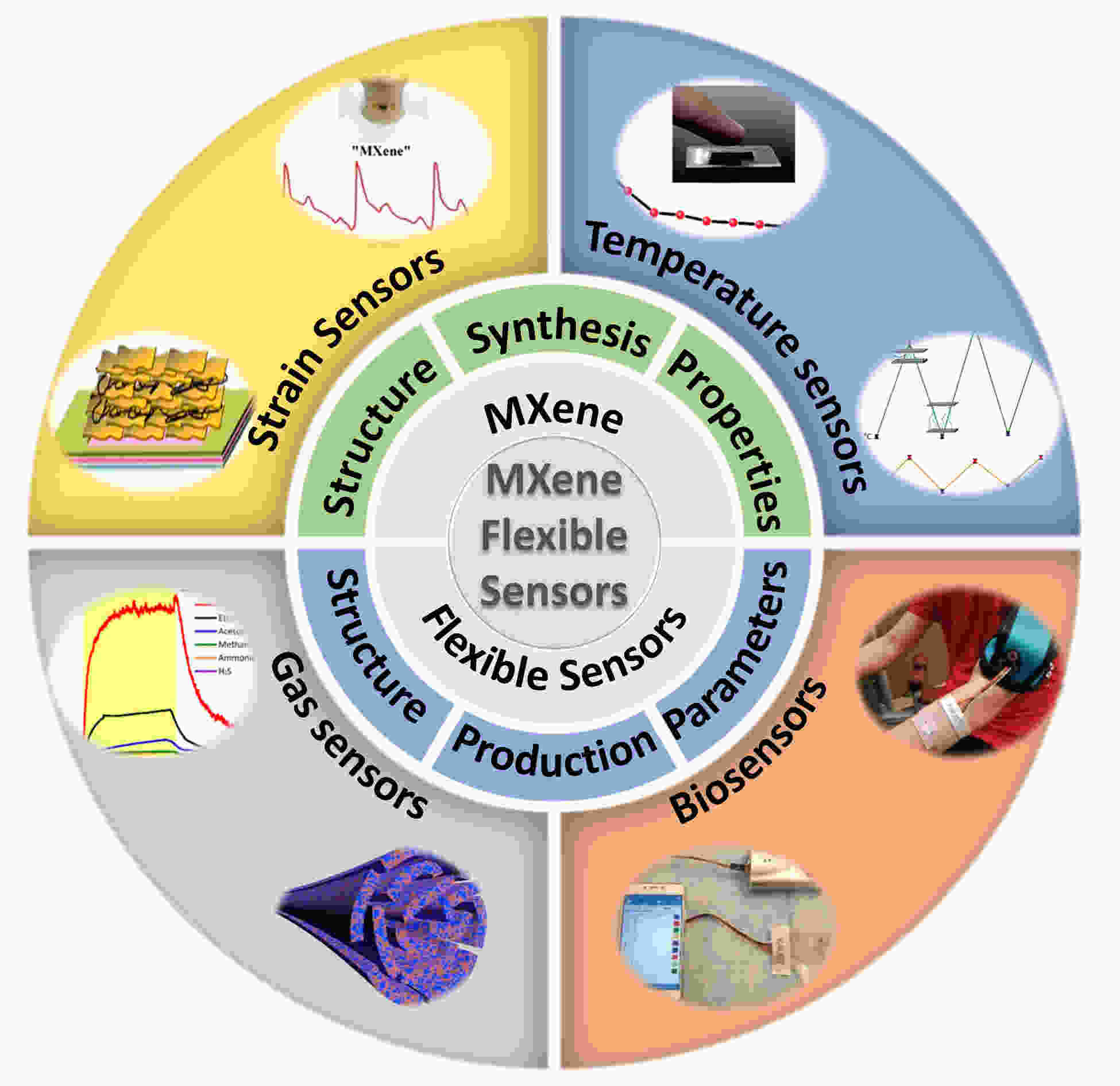
 下载:
下载:
